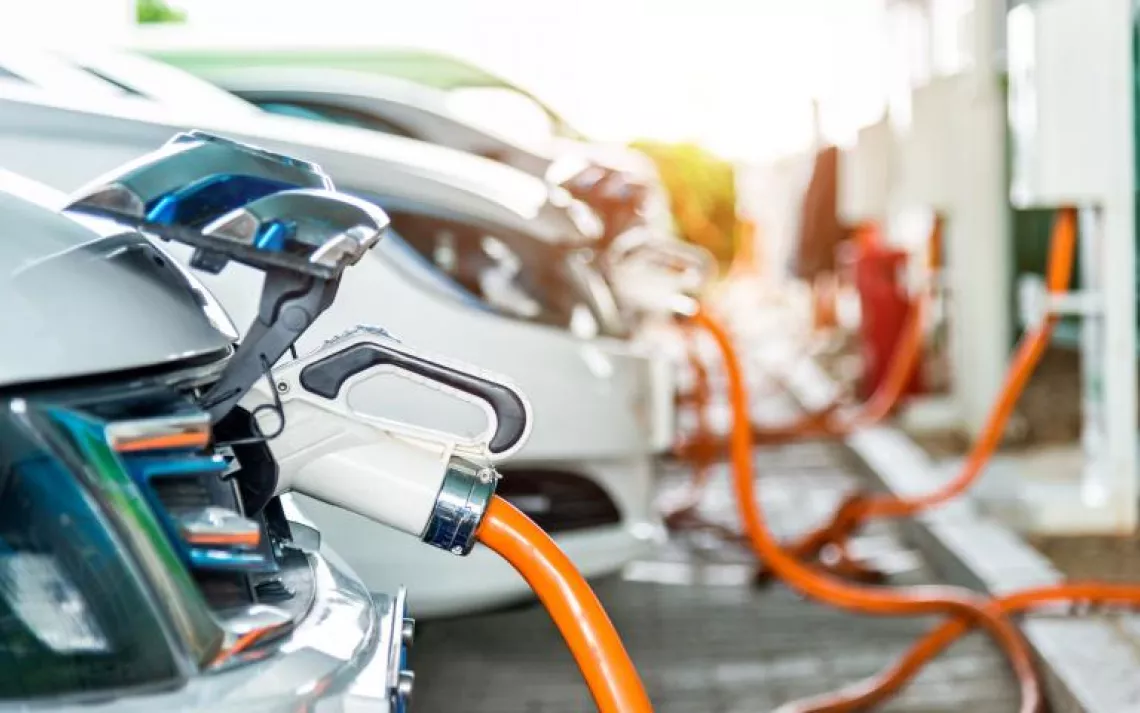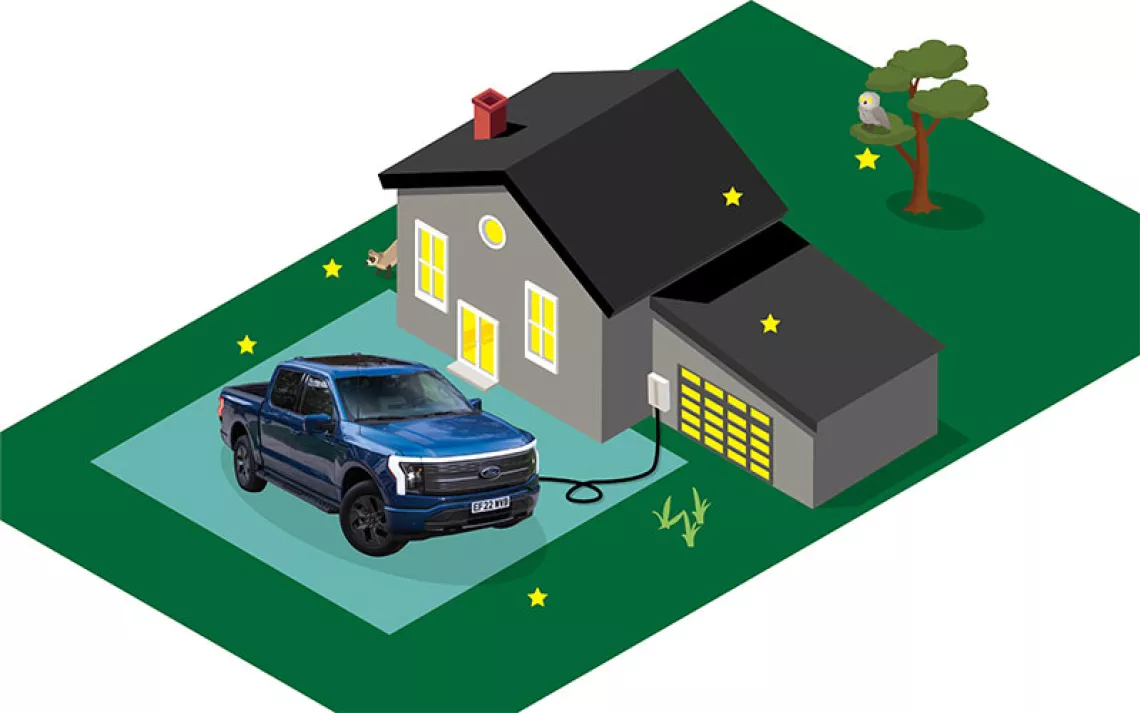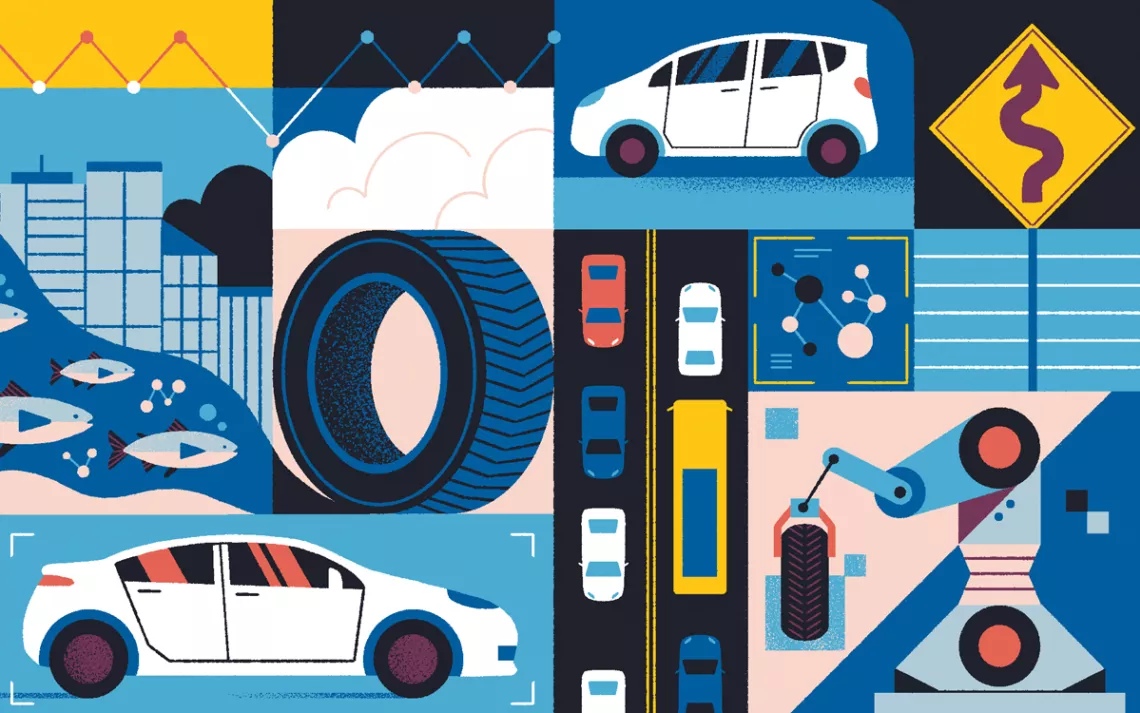Plugged In
Electric cars get ready to take over the road, quietly and powerfully

DRIVING A FORD FOCUS ELECTRIC AROUND SAN FRANCISCO was startling. Startling in that no one noticed. Here I was, slipping along city streets in a car that relies on no gasoline, no ExxonMobilShellChevron supply chain, no terror-fomenting oil country, and I might as well have picked up my white four-door at the Hertz counter at the San Francisco airport. Except for its unique Aston Martin-ish front grille and a few demure badges, the electric Focus looks like a standard Focus. At least with the oddly shaped hybrid Toyota Prius and the all-electric Nissan Leaf, a driver's green credentials are billboarded. Did I have to roll down the window and shout?
But anonymity is the new point. If the United States hopes to reduce its reliance on greenhouse-gas-spewing fossil fuels—the Sierra Club's goal is a 50 percent reduction in oil use by 2030—alternatives to gas swillers have to become mainstream. President Barack Obama wants to see a million electric and plug-in hybrid vehicles on the road by 2015. Yet only about 20,000 Chevy Volts, the most popular plug-in, were sold in the past two years. Total U.S. auto sales in 2012 alone are expected to surpass 14 million. So there's a distance left to travel.
Fortunately, the trip is well under way. As of press time, you can select from at least six all-electric vehicles. (See chart, above.) In addition, three plug-in hybrids (the Chevy Volt, Fisker Karma, and Toyota Prius Plug-in) allow you to drive a nominal number of miles on electric power alone before a small gasoline engine helps out. (With traditional hybrids like the popular Prius, the gas engine and electric motor work in tandem, so you rarely drive gas-free.) Another six carmakers have EVs scheduled for release in the near future.
What will it take to get millions of drivers to plug in? For car buyers not necessarily motivated by World Resources Institute climate-change studies, there's this enticement: Electric vehicles offer all-American driving fun. When you push the compact Focus's accelerator to pass a car on the freeway, it feels like you're driving a larger BMW or a Mercedes. That's because EVs have lots of torque: All the power of the electric motor is available the moment you press the gas pedal.
All-electric vehicles are also eerily quiet: With an electric power train, there's no engine revving or gears shifting—just forward motion. (An electric car's motor converts 60 percent of the current it receives from the utility grid into forward motion, compared with 20 percent efficiency for a gas-powered engine.) They are so quiet that carmakers have had to engineer software-generated sounds to alert unsuspecting pedestrians and cyclists of an approaching EV.
And they are cheap to operate, costing 2 to 3 cents per mile, as opposed to 15 to 16 cents per mile for a gas-powered car. The EPA calculates the miles per gallon equivalent (mpge) of electric cars, which is not the amount of miles you can actually drive before recharging but rather a way to compare the efficiency of apples (plug-in cars) and oranges (gasoline-powered cars) using the familiar miles per gallon rubric. The mpge of all-electric vehicles—from 89 for the Tesla Model S to 118 for the Honda Fit EV—makes a standard Prius, which is rated at 50 mpg combined, look like a fuel-economy poseur.
SO WHAT'S DELAYING OUR ZIPPY, quiet, low-maintenance future? Purchase price, for one. The least expensive mass-market all-electric car on the road today is the Mitsubishi i, which has a sticker price of about $29,000. Most EVs cost in the mid- to high $30,000s. Factor in a federal tax credit of $7,500 for most plug-in vehicles, and the bottom line stays within range of the price of the average new car sold in the United States: around $30,000. (Unless your choice is the Tesla, which comes in around $100,000. For that, you get a car that goes from zero to 60 in 4.4 seconds and travels 265 miles between charges...and has an 11-month waiting list.) Ford says the battery pack in the Focus EV costs $12,000 to $15,000, which helps explain why the well-equipped Focus EV costs some $25,000 more than a bare-bones gas-powered Focus.
If you're comparing an EV with an under-$20,000 high-mpg gas compact, payback becomes a slippery issue. According to research that TrueCar.com compiled for the New York Times, with gas at $3.85 per gallon, it will take 8.7 years for the Nissan Leaf's gas savings to make up for the approximately $11,000 price difference between it and the gas-powered Nissan Versa. But the payback day does come, with gas savings of $1,100 per year. In the meantime, do you want your dollars going to distant oil-producing nations and ExxonMobil?
It's probably "range anxiety" that makes potential EV purchasers hesitate most. That "freedom of the road" ethos takes a hit if you have to stop to recharge for three or four hours after driving 62 miles (Mitsubishi i), 73 miles (Leaf), 76 miles (Focus), or 88 miles (Coda). EV advocates point out that most Americans drive less than 40 miles per day, and if you charge up at home each night, well, no worries. All-electric car drivers typically install a high-capacity 240-volt charger, costing about $2,000, in their garage; otherwise, charging can take upwards of 20 hours on standard 120- volt household current.
My own white-knuckle moment came while approaching the Golden Gate Bridge in a Nissan Leaf that was telling me I could drive another 24 miles before I would be stone-cold stranded. I quickly calculated that my destination was only 14 miles away, and my anxiety subsided. But serendipitous discover-America side trips were off the table until I reached a plug.
Forget to plug in? Only halfway to your destination? The infrastructure of charging stations in North America, which currently number more than 11,000, is growing. In theory, "topping off" during the day should be convenient. But for now it takes a lot more advance planning than just popping into one of the 117,000 gas stations in the United States. In downtown San Rafael, California, I killed time while my Focus charged up by hanging out at a pool hall for a couple of hours. In a San Francisco parking garage, my Leaf and I jockeyed for position with a Chevy Volt owner for the one remaining 240-volt charging spot. Had the electric-car revolution occurred overnight? No, it turned out that an Apple software developers' conference was taking place nearby. The place was packed with "early adopters."
Volt guy settled for a slower-charging 120-volt plug. But neither of us would have been stranded had all three stations been in use. I had enough juice to get home, and the Volt, an "extended range" electric car, could simply have relied on its gas engine to keep rolling. Which is why, of the three plug-in vehicles I tested (Focus, Leaf, Prius), the Prius Plug-in is the one I would choose for a single-car household. It wasn't as fun as the Leaf or the Focus. In fact, it drove like an appliance on wheels—that is to say, just as perfunctorily as a regular Prius. But after I drained the batteries (in about 15 miles), the gas engine kicked in. Road trip, anyone?
The Berlin Wall was erected when I was a child, and I was as stunned as anybody that one day in late 1989 it was simply gone. I've never expected the choke hold of multinational oil conglomerates and OPEC nations to disappear. But as I zipped along suburban streets in a Nissan Leaf past a string of suddenly irrelevant gas stations tied to refinery emissions and tanker spills and tar-soaked sea turtles and Middle East oil fields and foreign entanglements, the possibilities seemed just as delightful.
Grid Locked?
"But electricity comes from coal!" say critics of electric vehicles. Since greenhouse-gas emissions are created when generating electricity, why bother to use it to fuel cars?
The nation's utility grid, however, is getting cleaner. Some 32 percent of America's electricity comes from burning coal, down from 50 percent five years ago. Electricity is one automotive fuel source that gets cleaner over time.
What matters most to an EV driver, of course, is where his or her own electricity comes from. According to State of Charge, a 2012 report by the Union of Concerned Scientists, for about half of the U.S. population, "electric vehicles produce lower global warming emissions than even the most efficient gasoline hybrids." A Nissan Leaf driven in California, a state whose utility grid has one of the least-polluting power mixes in the country, is responsible for releasing about as much carbon dioxide as a car that gets 78 miles per gallon. (Parts of New York, the Northwest, and Alaska are also among the "cleanest" electricity regions.) For a driver in Michigan, where nearly 60 percent of electricity comes from coal, that number is closer to 38 mpg.
Here's how TreeHugger puts it: "The environmental impact of driving an electric car will vary a lot more than a gas car, though even the worst case scenario (charging with coal) tend[s] to be close or slightly better than burning gasoline in an internal combustion engine."
 The Magazine of The Sierra Club
The Magazine of The Sierra Club



